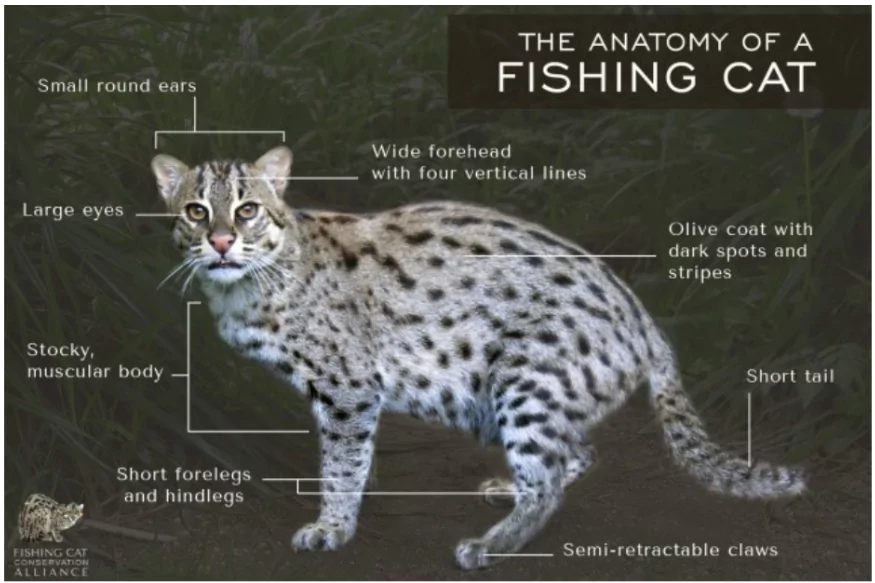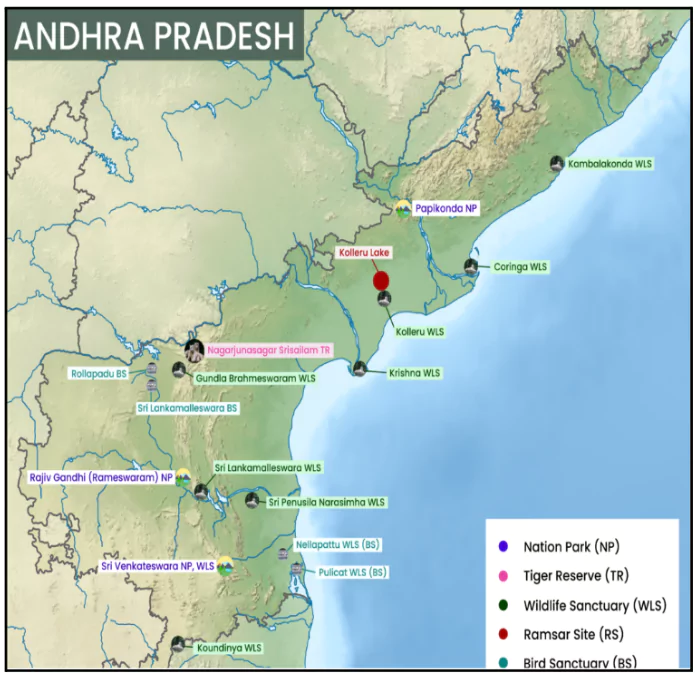India’s first Fishing Cat Collaring Project, led by the Wildlife Institute of India (WII)-Dehradun, is set to complete its second census in the coming weeks.
- The Fishing Cat Collaring Project spans three years and is scheduled to conclude by March/April 2025.
About Fishing Cat Collaring Project
- Aim: To study the fishing cat’s home range, behavior, habitat ecology, feeding habits, and space use.
- Fishing cats will be captured and fitted with lightweight collars containing Geographical Information System (GIS) equipment.
Enroll now for UPSC Online Classes
About Fishing Cat
- Habitat: Primarily inhabits wetlands, swamps, marshy areas around oxbow lakes, reed beds, tidal creeks, and mangrove forests.
 Global Distribution: Found mainly in Southeast Asia, including India, Sri Lanka, Bangladesh, Mekong Delta of Vietnam and Thailand, Pakistan, East Cambodia, and the northern Himalayan foothills.
Global Distribution: Found mainly in Southeast Asia, including India, Sri Lanka, Bangladesh, Mekong Delta of Vietnam and Thailand, Pakistan, East Cambodia, and the northern Himalayan foothills.- Distribution in India:
- Mangrove forests of the Sundarbans.
- In 2012, the fishing cat was declared as the State Animal of West Bengal
- River valleys of the Ganga and Brahmaputra near the Himalayan foothills
- Western Ghats
- Population Trends: The Chilika Lake, Asia’s largest brackish water lagoon, has 176 fishing cats, according to a census conducted by Chilika Development Authority (CDA) in collaboration with The Fishing Cat Project (TFCP).
- Conservation Status:
- IUCN: Vulnerable
- CITES: Appendix II
- Wildlife Protection Act, 1972: Schedule I
- Behavior and Features:
- Adept swimmer and frequently dives into water to catch fish.
- Nocturnal predator, feeding on frogs, crustaceans, snakes, birds, and scavenging carcasses of larger animals.
- Breeds throughout the year.
- Unique feature: Its muscular tail is shorter than that of a domestic cat and is ringed with 6-7 distinct, incomplete dark bands.
- The Fishing Cat Project (TFCP) is a long-term research and conservation initiative focused on the fishing cat.
- Launched in 2010, TFCP operates primarily in West Bengal and Odisha, India.
- Key Objectives of TFCP:
- Research: To study the ecology, behavior, and distribution of fishing cats in their natural habitats.
- Conservation: To implement effective conservation strategies to protect fishing cat populations and their habitats.
- Community Engagement: To raise awareness about the importance of fishing cat conservation among local communities and stakeholders.
- TFCP’s Impact:
- Scientific Research: TFCP has conducted extensive research on fishing cats, including population surveys, habitat assessments, and camera trap studies.
- Habitat Protection: The project has worked to protect and restore fishing cat habitats, such as wetlands and riverine ecosystems.
- Community Outreach: TFCP has successfully engaged local communities in conservation efforts through education programs, workshops, and alternative livelihood initiatives.
Check Out UPSC NCERT Textbooks From PW Store
About Coringa Wildlife Sanctuary (CWS)

- Location: Part of the Godavari estuary where the Coringa River meets the Bay of Bengal in Kakinada district, Andhra Pradesh.
- Habitat for Fishing Cat: By 2018, the population of fishing cats in the sanctuary was 115, as per the first survey of fishing cats.
- The number, however, has increased significantly over the past five years, given the frequency of sightings of the species recorded across and near the sanctuary.
- Significance:
- India’s second-largest mangrove forest, known for its substantial fishing cat population.
- The Krishna Wildlife Sanctuary in the Krishna estuarine forest, also in Andhra Pradesh, is another habitat for fishing cats.
- Geographical Features:
- Located between the sanctuary and the sea is “Hope Island,” which blocks the direct confluence of the Godavari River with the Bay of Bengal.
- Approximately 40% of the sanctuary comprises sea-backwaters.
- Vegetation: Composed of extensive mangrove and dry deciduous tropical forests.
- Flora: Dominated by mangrove species like Rhizophora spp., Avicennia spp., and Sonnertia spp.
- Fauna:
- Endangered mammals: Smooth Indian otter, fishing cat, jackal.
- Birds: Black-capped kingfisher, Brahminy kite, sea gulls, and reef heron.
- Special Feature: The sanctuary’s sea coast serves as a breeding ground for Olive Ridley turtles.
![]() 30 Dec 2024
30 Dec 2024

 Global Distribution: Found mainly in Southeast Asia, including India, Sri Lanka, Bangladesh, Mekong Delta of Vietnam and Thailand, Pakistan, East Cambodia, and the northern Himalayan foothills.
Global Distribution: Found mainly in Southeast Asia, including India, Sri Lanka, Bangladesh, Mekong Delta of Vietnam and Thailand, Pakistan, East Cambodia, and the northern Himalayan foothills.
